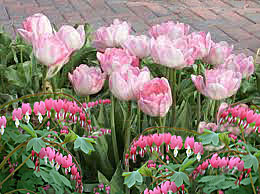 What could be more romantic that pale pink tulips growing beside the dainty flowers of bleeding heart? A color echo is created by the soft pink of the tulip and the rosey pink of the bleeding heart. Contrast is provided by the difference in size and shape of the flowers and the texture and color of the foliage. Use this combination in a shady spot with fertile, moist but well-drained soil where the bleeding heart with come back year after year; the tulips, however, will have to be planted each fall for the best effect.
What could be more romantic that pale pink tulips growing beside the dainty flowers of bleeding heart? A color echo is created by the soft pink of the tulip and the rosey pink of the bleeding heart. Contrast is provided by the difference in size and shape of the flowers and the texture and color of the foliage. Use this combination in a shady spot with fertile, moist but well-drained soil where the bleeding heart with come back year after year; the tulips, however, will have to be planted each fall for the best effect.

 Tulip ‘Angelique’
Tulip ‘Angelique’
The large, fully double blossoms of the ‘Angelique’ are carried on stiff stems and resemble peonies. They are fragrant and pale rose in color with darker rose flushes and pale creamy-pink edges. Like most other tulips, ‘Angelique’ is best treated as an annual and replanted every fall.
-
Bloom Time: Late spring
Size: 16-20” H
Hardiness: Zones 3-7

 Common Bleeding Heart (Dicentra spectabilis)
Common Bleeding Heart (Dicentra spectabilis)
This old fashioned plant native to Japan has been a shade garden staple for many years. The rosy pink flowers accented by a touch of white hang from long graceful arching stems. The foliage is lacy and fern-like. The plants form large clumps over time when grown in part shade and moist, well-drained soil. If the soil dries out or the temperatures are high plants commonly go dormant but return the following spring.
-
Bloom Time: Spring
Size: 18-24” H x 18” W
Hardiness: Zones 2-9
